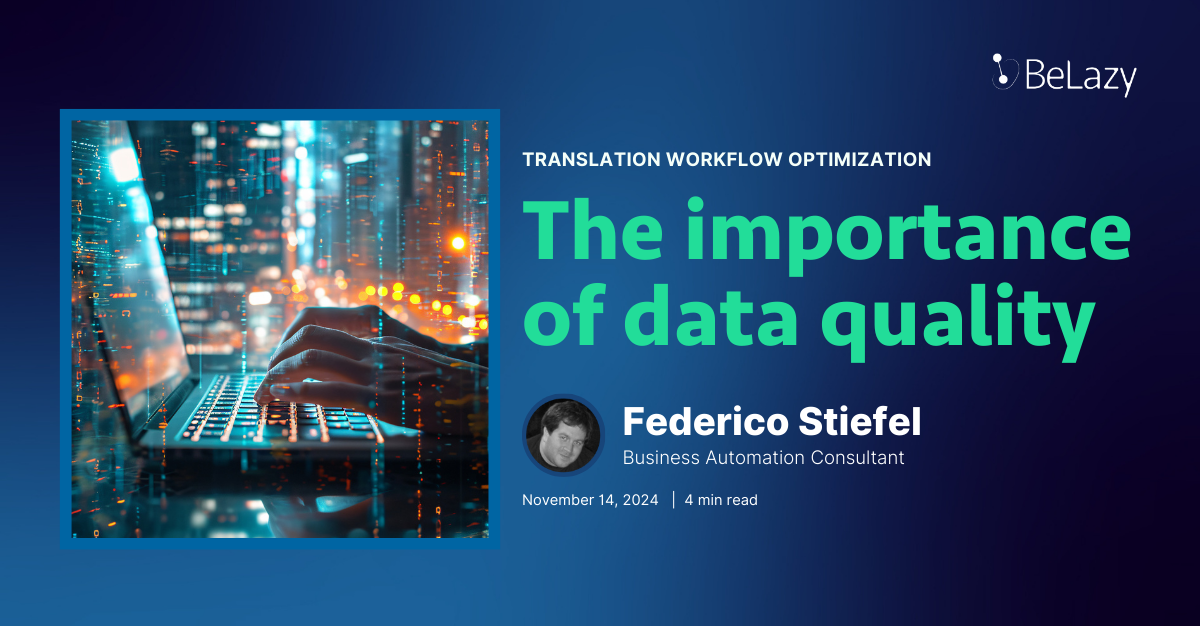BeLazy first TMS integration
If you have been following our path, you probably know that up until now BeLazy had only integrated vendor portals with business management systems. These processes have automated reasonably simple operations, always between two translation companies: copying project details and accepting projects. Today, we are proud to announce the first integration of the second generation, our first translation management system integration.
While vendor portal integrations are essentially useful for single language vendors (SLVs) that work for other translation companies (the multilingual vendors, MLVs), translation management system integrations can also be interesting for MLVs if their customer uses a translation management system such as Memsource, memoQ, XTM, GlobalLink, WorldServer, Transifex, etc.
For the first integration, we have selected to connect Memsource projects to XTRF projects.
Why Memsource? There are primarily two reasons:
- Memsource vendors have projects that suddenly "pop up” in their instance of Memsource.
- Memsource has a solid set of APIs and a generous policy: they do not charge extra for API usage (though they limit the number of calls in editions lower than Ultimate Edition).
Use cases
You may be asking what’s the point of implementing a Memsource to XTRF integration if there is already an existing one. The XTRF to Memsource integration automates project creation in Memsource if the user creates the project in XTRF first. Instead, the BeLazy integration takes Memsource projects that appear in your Memsource instance and creates the equivalent in XTRF.
There are three business scenarios where this integration can add value:
- The company works as a vendor for other Memsource users (enterprises or translation companies), thus projects assigned to them appear in their instance of Memsource.
- The company uses some of the content management system connectors of Memsource, and if the content in the CMS changes, these projects appear as projects in their Memsource instance.
- The company needs to prepare projects with file filter configuration, fine-tuning project settings and wants these projects to appear in XTRF when ready.
The challenges we had to overcome
Not every project needs to be created
If the project is already there in XTRF, it should not appear again as another project. We have implemented exception rules, this way you can use a pattern to exclude projects created by the XTRF Memsource integration.
Half-baked projects don’t need to be created
While you’re working on the project setup, the automation should not trigger. We also implemented this with naming conventions.
One Memsource instance works with multiple customers
A vendor portal is always representing one company, one customer, whereas you can have many customers from Memsource, and you need to map the right buyer/cost center/business unit to the right customer.
Memsource jobs are basically documents assigned
We had to find a clever way to merge jobs into actually manageable units, otherwise, translators would go crazy having to accept every single document separately (think about a website with 500 small XML files).
Analysis
While your customer can provide you with an analysis, it’s not a requirement in Memsource. Also, you may have partially analyzed jobs, i.e. not all jobs have an analysis. We have resolved this so that if you have a comprehensive analysis, we use that, if not, we create a new one – and that might take a minute or two.
Net rate schemes and price lists
The pricing module within Memsource is not extremely popular as most companies prefer to handle pricing via their translation management system. We take over pricing from Memsource if it happens to be there and generate pricing using XTRF data if it is not.
How does the integration work?
When a new project appears in Memsource, we check if the configuration is correct and there are no red flags. If so, it will be automatically created in XTRF. For this, we use an auto-approval rule which automatically accepts any new Memsource project. Thus you don’t even have to worry about tracking the BeLazy interface.
We have already discussed this integration with Memsource’s account managers, and they were pleased with the result. However, we also know technology companies often struggle to understand user behavior, this is why we are looking for early adopters of this integration.
Only XTRF?
If BeLazy is a middleware, why did we only implement Memsource towards XTRF? There isn’t any commercially available TMS to BMS integration in the market, so we simply wanted to get this is one up and running properly.
Our plan is to collect further feedback from XTRF users, pick the brain of Plunet users and move on to implement other integrations on both systems. We started with XTRF because 75% of companies that indicated interest in this integration were already using XTRF.
However, it’s not completely true that we have only implemented the integration with XTRF. BeLazy has a solid set of APIs that you can use to connect incoming projects to any proprietary business management system. If you use your own system and want to receive projects from Memsource, you can already do that.
What’s ahead?
- First, we would like to onboard a couple of companies to use the Memsource integration with XTRF smart projects and provide feedback on the implementation.
- We would like to discuss how Memsource projects are manually created in Plunet and XTRF Classic projects.
- At the moment, the vendor re-assignment is not a part of the integration: Memsource does not take the translators, proofreaders, if you assign them in XTRF. We are looking for a good way to implement this, and we are open to hearing suggestions.
Interested in another TMS?
We understand there are several translation management systems in the market, yet Memsource is our very first step. If you need to automate other kinds of workflows where your customer uses a TMS (for example you need to download and process project packages) please let us know.
We have recently launched the BeLazy Early Automators Program that makes it easy for our customers to achieve their integration goals.







